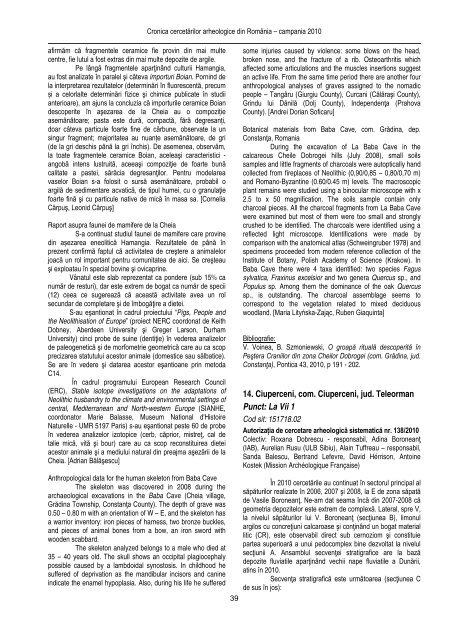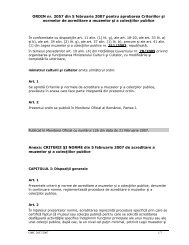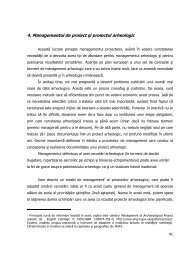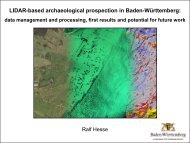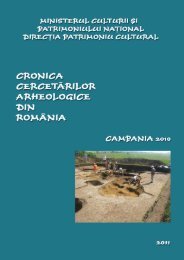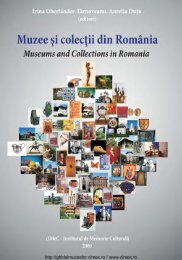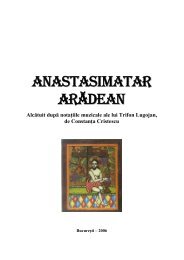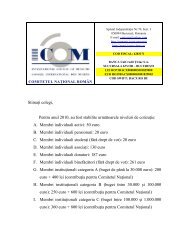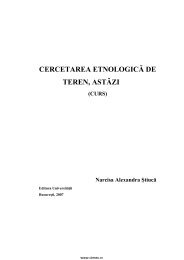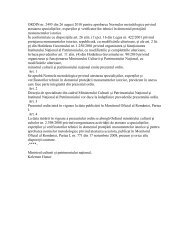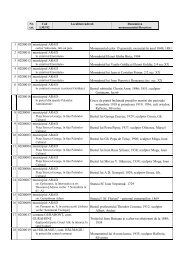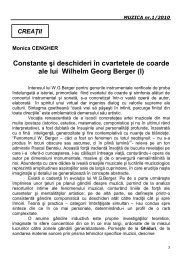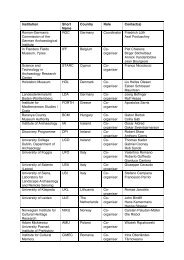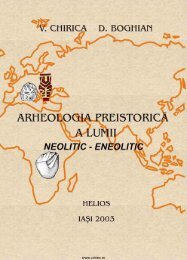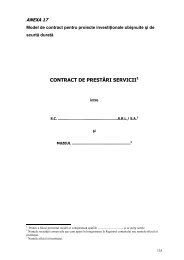Cronica-cercetarilor-arheologice-campania-2010 - cIMeC
Cronica-cercetarilor-arheologice-campania-2010 - cIMeC
Cronica-cercetarilor-arheologice-campania-2010 - cIMeC
Create successful ePaper yourself
Turn your PDF publications into a flip-book with our unique Google optimized e-Paper software.
afirmăm că fragmentele ceramice fie provin din mai multe<br />
centre, fie lutul a fost extras din mai multe depozite de argile.<br />
Pe lângă fragmentele aparţinând culturii Hamangia,<br />
au fost analizate în paralel şi câteva importuri Boian. Pornind de<br />
la interpretarea rezultatelor (determinări în fluorescentă, precum<br />
și a celorlalte determinări fizice şi chimice publicate în studii<br />
anterioare), am ajuns la concluzia că importurile ceramice Boian<br />
descoperite în aşezarea de la Cheia au o compoziție<br />
asemănătoare; pasta este dură, compactă, fără degresanți,<br />
doar câteva particule foarte fine de cărbune, observate la un<br />
singur fragment; majoritatea au nuanțe asemănătoare, de gri<br />
(de la gri deschis până la gri închis). De asemenea, observăm,<br />
la toate fragmentele ceramice Boian, aceleaşi caracteristici -<br />
angobă intens lustruită, aceeaşi compoziţie de foarte bună<br />
calitate a pastei, sărăcia degresanţilor. Pentru modelarea<br />
vaselor Boian s-a folosit o sursă asemănătoare, probabil o<br />
argilă de sedimentare acvatică, de tipul humei, cu o granulaţie<br />
foarte fină şi cu particule native de mică în masa sa. [Cornelia<br />
Cărpuş, Leonid Cărpuş]<br />
Raport asupra faunei de mamifere de la Cheia<br />
S-a continuat studiul faunei de mamifere care provine<br />
din așezarea eneolitică Hamangia. Rezultatele de până în<br />
prezent confirmă faptul că activitatea de creştere a animalelor<br />
joacă un rol important pentru comunitatea de aici. Se creşteau<br />
şi exploatau în special bovine şi ovicaprine.<br />
Vânatul este slab reprezentat ca pondere (sub 15% ca<br />
număr de resturi), dar este extrem de bogat ca număr de specii<br />
(12) ceea ce sugerează că această activitate avea un rol<br />
secundar de completare şi de îmbogăţire a dietei.<br />
S-au eşantionat în cadrul proiectului “Pigs, People and<br />
the Neolithisation of Europe” (proiect NERC coordonat de Keith<br />
Dobney, Aberdeen University şi Greger Larson, Durham<br />
University) cinci probe de suine (dentiţie) în vederea analizelor<br />
de paleogenetică şi de morfometrie geometrică care au ca scop<br />
precizarea statutului acestor animale (domestice sau sălbatice).<br />
Se are în vedere şi datarea acestor eşantioane prin metoda<br />
C14.<br />
În cadrul programului European Research Council<br />
(ERC), Stable isotope investigations on the adaptations of<br />
Neolithic husbandry to the climate and environmental settings of<br />
central, Mediterranean and North-western Europe (SIANHE,<br />
coordonator Marie Balasse, Museum National d'Histoire<br />
Naturelle - UMR 5197 Paris) s-au eşantionat peste 60 de probe<br />
în vederea analizelor izotopice (cerb, căprior, mistreţ, cal de<br />
talie mică, vită şi bour) care au ca scop reconstituirea dietei<br />
acestor animale şi a mediului natural din preajma aşezării de la<br />
Cheia. [Adrian Bălăşescu]<br />
Anthropological data for the human skeleton from Baba Cave<br />
The skeleton was discovered in 2008 during the<br />
archaeological excavations in the Baba Cave (Cheia village,<br />
Grădina Township, Constanţa County). The depth of grave was<br />
0.50 – 0.80 m with an orientation of W – E, and the skeleton has<br />
a warrior inventory: iron pieces of harness, two bronze buckles,<br />
and pieces of animal bones from a bow, an iron sword with<br />
wooden scabbard.<br />
The skeleton analyzed belongs to a male who died at<br />
35 – 40 years old. The skull shows an occipital plagiocephaly<br />
possible caused by a lambdoidal synostosis. In childhood he<br />
suffered of deprivation as the mandibular incisors and canine<br />
indicate the enamel hypoplasia. Also, during his life he suffered<br />
<strong>Cronica</strong> cercetărilor <strong>arheologice</strong> din România – <strong>campania</strong> <strong>2010</strong><br />
39<br />
some injuries caused by violence: some blows on the head,<br />
broken nose, and the fracture of a rib. Osteoarthritis which<br />
affected some articulations and the muscles insertions suggest<br />
an active life. From the same time period there are another four<br />
anthropological analyses of graves assigned to the nomadic<br />
people – Tangâru (Giurgiu County), Curcani (Călăraşi County),<br />
Grindu lui Dănilă (Dolj County), Independenţa (Prahova<br />
County). [Andrei Dorian Soficaru]<br />
Botanical materials from Baba Cave, com. Grădina, dep.<br />
Constanţa, Romania<br />
During the excavation of La Baba Cave in the<br />
calcareous Cheile Dobrogei hills (July 2008), small soils<br />
samples and little fragments of charcoals were autoptically hand<br />
collected from fireplaces of Neolithic (0,90/0,85 – 0,80/0,70 m)<br />
and Romano-Byzantine (0.60/0.45 m) levels. The macroscopic<br />
plant remains were studied using a binocular microscope with x<br />
2.5 to x 50 magnification. The soils sample contain only<br />
charcoal pieces. All the charcoal fragments from La Baba Cave<br />
were examined but most of them were too small and strongly<br />
crushed to be identified. The charcoals were identified using a<br />
reflected light microscope. Identifications were made by<br />
comparison with the anatomical atlas (Schweingruber 1978) and<br />
specimens proceeded from modern reference collection of the<br />
Institute of Botany, Polish Academy of Science (Krakow). In<br />
Baba Cave there were 4 taxa identified: two species Fagus<br />
sylvatica, Fraxinus excelsior and two genera Quercus sp., and<br />
Populus sp. Among them the dominance of the oak Quercus<br />
sp., is outstanding. The charcoal assemblage seems to<br />
correspond to the vegetation related to mixed deciduous<br />
woodland. [Maria Lityńska-Zając, Ruben Giaquinta]<br />
Bibliografie:<br />
V. Voinea, B. Szmoniewski, O groapă rituală descoperită în<br />
Peştera Craniilor din zona Cheilor Dobrogei (com. Grădina, jud.<br />
Constanţa), Pontica 43, <strong>2010</strong>, p 191 - 202.<br />
14. Ciuperceni, com. Ciuperceni, jud. Teleorman<br />
Punct: La Vii 1<br />
Cod sit: 151718.02<br />
Autorizația de cercetare arheologică sistematică nr. 138/<strong>2010</strong><br />
Colectiv: Roxana Dobrescu - responsabil, Adina Boroneanţ<br />
(IAB), Aurelian Rusu (ULB Sibiu), Alain Tuffreau – responsabil,<br />
Sanda Balescu, Bertrand Lefevre, David Hérrison, Antoine<br />
Kostek (Mission Archéologique Française)<br />
În <strong>2010</strong> cercetările au continuat în sectorul principal al<br />
săpăturilor realizate în 2006, 2007 şi 2008, la E de zona săpată<br />
de Vasile Boroneanţ. Ne-am dat seama încă din 2007-2008 că<br />
geometria depozitelor este extrem de complexă. Lateral, spre V,<br />
la nivelul săpăturilor lui V. Boroneanţ (secţiunea B), limonul<br />
argilos cu concreţiuni calcaroase şi conţinând un bogat material<br />
litic (CR), este observabil direct sub cernoziom şi constituie<br />
partea superioară a unui pedocomplex bine dezvoltat la nivelul<br />
secţiunii A. Ansamblul secvenţei stratigrafice are la bază<br />
depozite fluviatile aparţinând vechii nape fluviatile a Dunării,<br />
atins în <strong>2010</strong>.<br />
Secvenţa stratigrafică este următoarea (secţiunea C<br />
de sus în jos):


